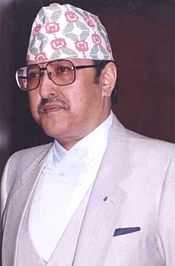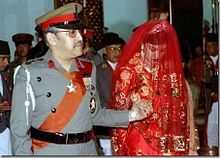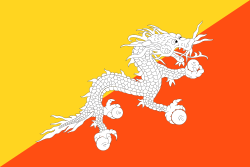Birendra of Nepal
| Birendra Bīrendra Bīr Bikram Shāh | |
|---|---|
|
Late King Birendra in traditional Nepali Dress | |
| King of Nepal | |
| Reign |
31 January 1972 – 1 June 2001 |
| Coronation | 24 February 1975 |
| Predecessor | Mahendra |
| Successor | Dipendra |
| Consort | Aishwarya Rajya Laxmi Devi Shah |
| Issue |
Crown Prince Dipendra Princess Shruti Prince Nirajan |
| House | Shah |
| Father | King Mahendra Bir Bikram Shah Dev |
| Mother | Indra Rajya Laxmi Devi |
| Born |
29 December 1945 Narayanhiti Royal Palace, Kathmandu, Nepal |
| Died |
1 June 2001 (aged 55) Narayanhiti Royal Palace, Kathmandu, Nepal |
| Religion | Hindu |
| Signature |
|
Birendra Bir Bikram Shah (वीरेन्द्र वीर विक्रम शाह) (29 December 1945 – 1 June 2001) was the 11th King of Nepal and a South Asian statesman. The eldest son of King Mahendra, whom he succeeded in 1972, he reigned until his death in the 2001 Nepalese royal massacre.
Personality
From a very young age, Birendra was described even by his school teachers as a very kind and emotional prince. King Birendra was described as one of the few Nepalese monarchs who wanted the Nepalese people to experience real democracy. This was observed in the 2038 B.S. Janmat Sangraha (1980 Referendum) when he wanted the people to choose whether they wanted 'Multiparty Democracy' or a 'Reformed Panchayat System'. Also, in People's Movement I, he decided to establish 'Constitutional Monarchy' in Nepal instead of fighting for dictatorship.
In 1989, when the People’s Movement I was taking momentum, at the condition of safeguarding the panchayat system, the Indians had put forward some conditions to King Birendra aimed at taking control over national sovereignty. If the King had accepted these conditions, the panchayat system would not have ended. But the king said that, "It is better to surrender to the people rather than surrender to India.” [1]
Some historians would speculate that Late King Birendra's democratic views and simple nature lead to the success of the People's Movement I (1990). He is credited for introducing SAARC in Asia in order to strengthen the foreign relations of Nepal with the South Asian countries.
Early life
King Birendra was born at the Narayanhiti Royal Palace in Kathmandu as the eldest son of the then Crown Prince Mahendra Bir Bikram Shah Dev and his first wife, Crown Princess Indra Rajya Laxmi.[2]
King Birendra had spent eight years studying at St Joseph's College, a Jesuit school in Darjeeling, with his brother Gyanendra. On 13 March 1955 his grandfather King Tribhuvan died and his father succeeded to the Nepalese throne. With his father's ascension King Birendra became the Crown Prince of Nepal.
In 1959 King Birendra enrolled at Eton College in the United Kingdom. After studying at Eton until 1964 he returned to Nepal where he began to explore the country by travelling by foot to the remote parts of the country where he lived on whatever was available in the villages and monasteries.[2] He later completed his education by spending some time at the University of Tokyo before studying political theory at Harvard University from 1967 to 1968.[3] Late King Birendra enjoyed to travel in his youth and went on trips to Canada, Latin America, Africa and a number of Asian countries. He was also an art collector and supporter of Nepalese crafts people and artists. He also learnt to fly helicopters.[4]
King Birendra was married to Aishwarya Rajya Laxmi Devi Rana from the Rana family on 27 February 1970.[5] The wedding, which was billed as one of the most lavish Hindu nuptial ceremonies in history, cost $9.5 million to stage.[6] King Birendra and Queen Aishwarya had three children.
- Prince Dipendra (27 June 1971 – 4 June 2001).
- Princess Shruti (15 October 1976 – 1 June 2001).
- Prince Nirajan (6 November 1977 – 1 June 2001).
Early reign

Birendra succeeded the Nepalese throne on 31 January 1972 after the death of his father, King Mahendra. On his ascension he was effectively an absolute monarch as he inherited a country where political parties were banned and he ruled through a system of local and regional councils known as panchayats.[4] Birendra resented the absolute monarch tag maintaining that he presided over a democracy in which representatives to the assembly were indirectly elected and saying that his poor and backward country could not afford a democracy based on party politics and that it needed firm and decisive government.[7] His first trips abroad as king were to India in October 1973 and China two months later as he believed that Nepal, sandwiched between the two Asian powers, should have good relations with both.[8]
In an attempt to maintain the panchayat system of government prominent leaders of the Nepali Congress Party were arrested.[4] Because of the growing pro democracy movement Birendra announced that a referendum to decide between a non-party and a multi-party system would be held. The referendum was held in May 1980 with the non-party system winning by a margin of 55% to 45%.[8] During the 1980s the restraints that had been imposed on political organisations were starting to ease and liberal student-led groups were starting to appear demanding constitutional change in Nepal.[3] He was made a British Field Marshal in 1980.
Democratic era


In 1990 a series of strikes and pro-democracy riots broke out in Nepal. Because of the rioting Birendra agreed to become a constitutional monarch. He appointed an independent Constitution Recommendation Commission to represent the main opposition factions and to prepare a new constitution to accommodate their demands for political reform. The commission presented him with the draft of the proposed constitution on 10 September 1990. The new constitution would make Birendra head of state of a constitutional monarchy with a system of multiparty democracy. The draft constitution was approved by the Prime Minister Krishna Prasad Bhattarai and his cabinet and so on 9 November 1990 Birendra promulgated the new constitution transforming Nepal into a constitutional monarchy.[9]
However, the quarrels between various political parties and numerous social problems led to the Nepalese Civil War, a conflict between Maoist rebels and government forces, which lasted from 1996 until 2006.
Zone of Peace Proposal
In 1975, on the occasion of the coronation ceremony, the King presented the proposal to recognise Nepal as a zone of peace with a view to promote new dimension to Nepal's non-alignment policy, and to accept peace as the most for the important progress of the nation. Nepal as a zone of peace was recognised by 116 countries of the world.
Death
Nepal's stability was threatened even more when Birendra and his family (including Queen Aishwarya) were massacred at a royal dinner on 1 June 2001.
Almost all of the Royal family members were killed in the massacre except Gyanendra Shah, Birendra's younger brother. Dipendra was proclaimed king but died a few days later of self-inflicted gunshot wounds sustained in the massacre. Thus Gyanendra then became king.
Eyewitness reports and an official investigation (carried by a two-man committee made up of the Chief Justice of the Supreme Court Keshav Prasad Upadhaya and the Speaker of the House of Representatives Taranath Ranabhat),[10] confirmed that Dipendra was the gunman. A detailed investigation is impossible as the "Tribhuvan Sadan" (the building where the massacre occurred) was demolished by the Gyanendra government.[11]
| Monarchical styles of His Majesty King Birendra Bir Bikram Shah Dev | |
|---|---|
 | |
| Reference style | His Royal Majesty |
| Spoken style | Your Royal Majesty |
| Alternative style | Sir |
Titles and honours
- National orders
- Sovereign of the Order of Nepal Pratap Bhaskara
- Sovereign of the Order of Ojaswi Rajanya
- Sovereign of the Order of Nepal Taradisha
- Sovereign of the Order of Tri Shakti Patta
- Sovereign of the Order of Gorkha Dakshina Bahu
- Most Glorious Mahendra Chain
- King Mahendra Investiture Medal (02/05/1956)
- Foreign orders
-
 Thailand: Collar of Order of the Rajamitrabhorn, (1979)
Thailand: Collar of Order of the Rajamitrabhorn, (1979) -
 Denmark : Knight of the Order of the Elephant, (17/10/1989)
Denmark : Knight of the Order of the Elephant, (17/10/1989) -
 Japan : Collar of the Order of the Chrysanthemum, (1975)
Japan : Collar of the Order of the Chrysanthemum, (1975) -
 Cyprus : Collar of the Order of Makarios III of Cyprus, (1980)
Cyprus : Collar of the Order of Makarios III of Cyprus, (1980) -
.svg.png) Kingdom of Laos : Collar of the Order of the Million Elephants and the White Parasol, (1970)
Kingdom of Laos : Collar of the Order of the Million Elephants and the White Parasol, (1970) -
 Netherlands : Knight of the Order of the Gold Lion of the House of Nassau, (1975)
Netherlands : Knight of the Order of the Gold Lion of the House of Nassau, (1975) -
 France : Knight Grand Cross of the Legion of Honour, (1983)
France : Knight Grand Cross of the Legion of Honour, (1983) -
 Germany : Grand Cross Special Class of the Order of Merit of the Federal Republic of Germany, (1986)
Germany : Grand Cross Special Class of the Order of Merit of the Federal Republic of Germany, (1986) -
 Spain : Collar of the Royal Order of Charles III, (19/09/1983)[12]
Spain : Collar of the Royal Order of Charles III, (19/09/1983)[12] -
 Pakistan : Nishan-e-Pakistan, (1983)
Pakistan : Nishan-e-Pakistan, (1983) -
 Romania : Grand Cross of the Order of the Star of Romania, (1975)
Romania : Grand Cross of the Order of the Star of Romania, (1975) -
 Chile : Grand Cross with Collar of the Order of Merit of Chile, (1989)
Chile : Grand Cross with Collar of the Order of Merit of Chile, (1989) -
 Finland : Grand Cross with Collar of the Order of the White Rose, (1988)
Finland : Grand Cross with Collar of the Order of the White Rose, (1988) -
 Egypt : Collar of the Order of the Nile, (1974)
Egypt : Collar of the Order of the Nile, (1974) -
 Yugoslavia : Great Star of the Order of the Yugoslav Star, (02/02/1974)
Yugoslavia : Great Star of the Order of the Yugoslav Star, (02/02/1974) -
.svg.png) Romania: Knight Grand Cross of the Order of 23 August (1987)[13]
Romania: Knight Grand Cross of the Order of 23 August (1987)[13] -
 United Kingdom: Royal Victorian Chain (23/02/1975)[13]
United Kingdom: Royal Victorian Chain (23/02/1975)[13] -
 Bhutan : King Jigme Singye Investiture Medal (02/06/1974)[14]
Bhutan : King Jigme Singye Investiture Medal (02/06/1974)[14]
Ancestry
| Ancestors of Birendra of Nepal | ||||||||||||||||||||||||||||||||||||||||||||||||||||||||||||||||||||||||||||||||||||||||||||||||||||||||||||||||||||||||||||||||||||||||||||||||||||||||||||||||||||||||||||||||||||||||||||||||||||||||||||||||||||||||||||||||||||||||||||||||||||||||||||||||||||||||||||||||||||||||||||||||||||||||||||||||||||||||||||||||||||||||||||||||||
|---|---|---|---|---|---|---|---|---|---|---|---|---|---|---|---|---|---|---|---|---|---|---|---|---|---|---|---|---|---|---|---|---|---|---|---|---|---|---|---|---|---|---|---|---|---|---|---|---|---|---|---|---|---|---|---|---|---|---|---|---|---|---|---|---|---|---|---|---|---|---|---|---|---|---|---|---|---|---|---|---|---|---|---|---|---|---|---|---|---|---|---|---|---|---|---|---|---|---|---|---|---|---|---|---|---|---|---|---|---|---|---|---|---|---|---|---|---|---|---|---|---|---|---|---|---|---|---|---|---|---|---|---|---|---|---|---|---|---|---|---|---|---|---|---|---|---|---|---|---|---|---|---|---|---|---|---|---|---|---|---|---|---|---|---|---|---|---|---|---|---|---|---|---|---|---|---|---|---|---|---|---|---|---|---|---|---|---|---|---|---|---|---|---|---|---|---|---|---|---|---|---|---|---|---|---|---|---|---|---|---|---|---|---|---|---|---|---|---|---|---|---|---|---|---|---|---|---|---|---|---|---|---|---|---|---|---|---|---|---|---|---|---|---|---|---|---|---|---|---|---|---|---|---|---|---|---|---|---|---|---|---|---|---|---|---|---|---|---|---|---|---|---|---|---|---|---|---|---|---|---|---|---|---|---|---|---|---|---|---|---|---|---|---|---|---|---|---|---|---|---|---|---|---|---|---|---|---|---|---|---|---|---|---|---|---|---|---|---|---|---|---|---|---|---|---|---|---|---|---|---|---|---|---|---|---|---|---|---|
| ||||||||||||||||||||||||||||||||||||||||||||||||||||||||||||||||||||||||||||||||||||||||||||||||||||||||||||||||||||||||||||||||||||||||||||||||||||||||||||||||||||||||||||||||||||||||||||||||||||||||||||||||||||||||||||||||||||||||||||||||||||||||||||||||||||||||||||||||||||||||||||||||||||||||||||||||||||||||||||||||||||||||||||||||||
References
- ↑ "News".
- ↑ 2.0 2.1 "King Birendra of Nepal". Daily Telegraph. 23 August 2001. Retrieved 21 July 2008.
- ↑ 3.0 3.1 "Birendra: Nepal's monarch of change". BBC. 2 June 2001. Retrieved 21 July 2008.
- ↑ 4.0 4.1 4.2 Crossette, Barbara (3 June 2001). "Birendra, 55, Ruler of Nepal's Hindu Kingdom". New York Times. Retrieved 21 July 2008.
- ↑ Mainali, Pramod (2000). Milestones of History. p. 111. ISBN 99946-960-4-1.
- ↑ "Marriage of Convenience". Time Magazine. 9 March 1970. Retrieved 21 July 2008.
- ↑ Tully, Mark (23 April 2002). "The late King Birendra of Nepal". CNN. Retrieved 21 July 2008.
- ↑ 8.0 8.1 Malhotra, Inder (4 June 2001). "King Birendra of Nepal". The Guardian. Retrieved 21 July 2008.
- ↑ "The Constitution of 1990". Country Studies. Retrieved 21 July 2008.
- ↑ Nepal massacre inquiry begins, at long last
- ↑ "Prince blamed for Nepal massacre". BBC News. 14 June 2001. Retrieved 6 February 2011.
- ↑ Boletín Oficial del Estado
- ↑ 13.0 13.1 Royal Ark
- ↑ Final Programmes for The Coronation and The Silver Jubilee Celebration
| Regnal titles | ||
|---|---|---|
| Preceded by Mahendra Bir Bikram Shah |
Crown Prince of Nepal 1955–1972 |
Succeeded by Dipendra Bir Bikram Shah |
| King of Nepal 1972–2001 | ||
